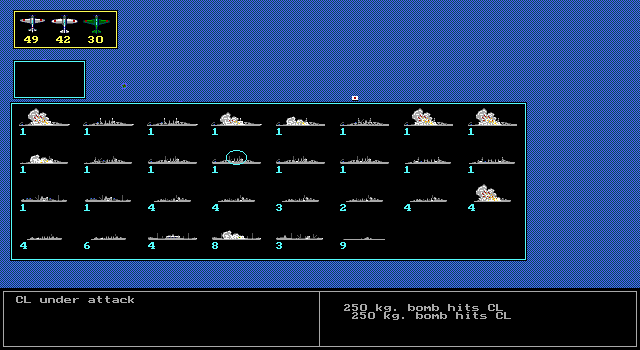Retro Replay Review
Gameplay
The heart of Gary Grigsby’s Pacific War lies in its deeply strategic turn-based gameplay. Every campaign turn challenges you to juggle naval fleets, air wings, ground forces, and logistics across an expansive Pacific theatre. The attention to detail is staggering: each ship class, airplane model, artillery piece, and armored division is faithfully represented. Players can launch carrier strikes, orchestrate amphibious landings, and manage supply chains that determine victory or defeat on remote island airstrips.
(HEY YOU!! We hope you enjoy! We try not to run ads. So basically, this is a very expensive hobby running this site. Please consider joining us for updates, forums, and more. Network w/ us to make some cash or friends while retro gaming, and you can win some free retro games for posting. Okay, carry on 👍)
A major strength is the flexibility in how you engage with the AI or fellow players. You can face off against the computer on either side of the conflict, switch to hotseat mode with friends, or conduct long-distance battles via play-by-email. A built-in recorder tracks every move—player and AI alike—allowing detailed post-game analysis of your strategic decisions. If you ever spot a glitch in balance or wish to tinker, the included database editor gives you full control over unit statistics and scenario parameters.
Despite its complexity, Pacific War offers a surprisingly smooth learning curve thanks to contextual tooltips and an extensive manual. Early turns introduce basic mechanics like fleet movement and air missions, then gradually layer in supply rules, weather effects, and amphibious doctrine. For die-hard wargamers, the sheer depth can be intoxicating; for newcomers, the challenge is substantial but rewarding once you grasp the fundamentals of joint operations in a vast maritime conflict zone.
Graphics
Originally released in 1992, the revamped Pacific War features completely overhauled artwork that brings every unit to life on high-resolution maps. Ships, planes, and ground units are now rendered with crisp sprites that are not only aesthetically pleasing but also clear and functional during play. Hex-based terrain—ranging from coral atolls to mountainous islands—uses distinct color palettes to denote movement costs and combat modifiers at a glance.
User interface improvements modernize the classic wargame look without sacrificing clarity. Unit information panels, strategic overviews, and combat result tables are neatly organized, ensuring that tracking your multi-stage naval battles and air sorties doesn’t feel like wresting with an outdated DOS program. Zooming in on key areas allows you to appreciate unit icons in detail while a zoomed-out view keeps the broader theater of war firmly in sight.
Subtle animations—such as carrier launches, bombing runs, and naval gunfire—add a dynamic flair to what was once a static experience. Though the game doesn’t pursue photo-realism, its stylistic coherence and functional design make every strategic choice visually rewarding. The new art assets, combined with color-coded action indicators, contribute to immersion by keeping you focused on planning your next decisive strike rather than puzzling over visual clutter.
Story
Gary Grigsby’s Pacific War doesn’t follow a scripted narrative; instead, it creates its own story through emergent gameplay rooted in World War II history. You choose to command either the Imperial Japanese forces or the Allies, each side offering unique strategic challenges and historically inspired scenarios. From the opening salvo at Pearl Harbor to the brutal island-hopping campaigns in the Solomons, every decision shapes an evolving tale of supply shortages, tactical triumphs, and desperate last stands.
The campaign structure includes a series of interconnected scenarios that simulate major operations such as Midway, Guadalcanal, and Leyte Gulf. Success or failure in one scenario influences reinforcements, morale, and available resources in subsequent engagements. This branching campaign design ensures that your playthrough feels like a personalized saga, where a poorly timed carrier raid could lead to a shortage of pilots in later battles, or a daring amphibious assault might open a new front entirely.
While there are no voiced cut-scenes or scripted dialogues, the “story” emerges organically from strategic choices and historical contingency. Watching your carrier task force evade a superior enemy fleet or witnessing the grinding advance of US Marines through dense jungle creates a sense of drama on par with many narrative-driven titles. For history buffs, each turn feels like writing a new chapter in the Pacific War’s grand saga.
Overall Experience
As a free download from Matrix Games, Gary Grigsby’s Pacific War delivers an astonishing value proposition. You get a comprehensive, deeply detailed wargame without spending a dime—something rarely seen in the genre’s modern landscape. The inclusion of hotseat, PBEM, and a full scenario recorder underscores the developers’ commitment to community-driven play and long-term engagement.
The learning curve is steep, but the payoff is immense: mastering combined arms operations, balanced logistics, and naval-air coordination is intensely satisfying. The robust database editor also invites players to create custom scenarios or tweak unit stats, ensuring that replayability extends far beyond the base game’s historical campaigns. Whether you’re aiming to rewrite history with a bold Japanese push toward Australia or test Allied industrial might in the Philippines, the tools are at your fingertips.
In short, Pacific War stands as a testament to classic wargame design brought into the modern era. Its depth, flexibility, and no-cost accessibility make it a must-download for strategy enthusiasts and history fans alike. While it demands patience and strategic thinking, few titles offer such a comprehensive simulation of the Pacific theatre—let alone for free. Dive in, learn the intricacies, and prepare for some of the most challenging and rewarding turn-based warfare you’ll find anywhere.
 Retro Replay Retro Replay gaming reviews, news, emulation, geek stuff and more!
Retro Replay Retro Replay gaming reviews, news, emulation, geek stuff and more!







Reviews
There are no reviews yet.